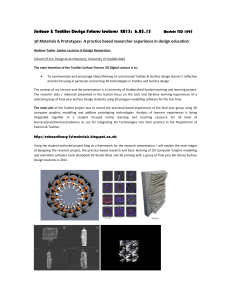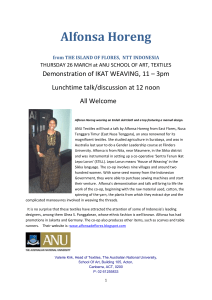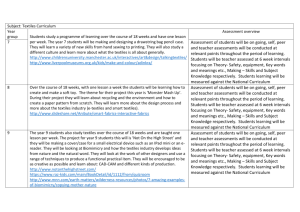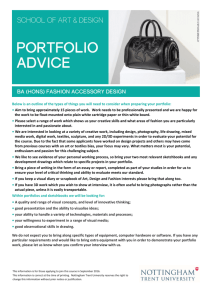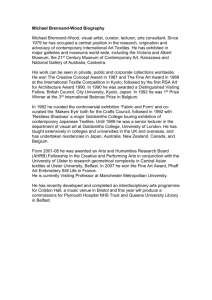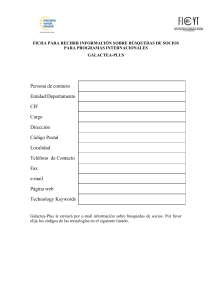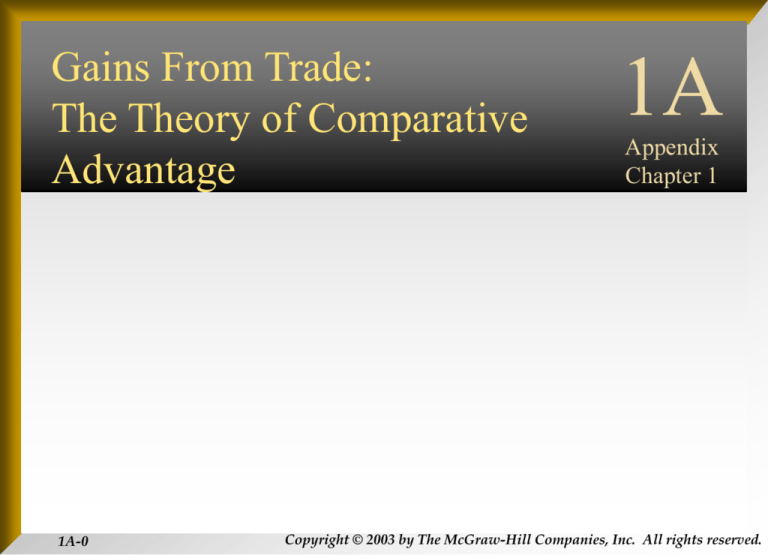
Gains From Trade:
The Theory of Comparative
Appendix
Advantage
Chapter 1
INTERNATIONAL
1A
FINANCIAL
MANAGEMENT
Third Edition
EUN / RESNICK
1A-0
Copyright © 2003 by The McGraw-Hill Companies, Inc. All rights reserved.
The Theory of
Comparative Advantage
Definition: a comparative advantage exists when
one party can produce a good or service at a lower
opportunity cost than another party.
1A-1
Copyright © 2001
2003 by The McGraw-Hill Companies, Inc. All rights reserved.
The Geometry of Comparative Advantage
Consider the example given in appendix 1A.
There are two countries, A and B, who can each
produce only food and textiles.
Initially they do not trade with each other.
1A-2
Copyright © 2001
2003 by The McGraw-Hill Companies, Inc. All rights reserved.
The Geometry of Comparative Advantage
Textiles
180
A production possibilities curve shows the various amounts
of food or textiles that each country can make.
The production possibilities of country A are such that if
they concentrated 100% of their resources into the
production of textiles, they could produce 180 million
yards of textiles.
If country A chose to concentrate 100% of their resources
into the production of food, they could produce as much
as 300 million pounds of food.
300
1A-3
Food
Country A can produce any combination of
food and textiles between these two points.
Copyright © 2003 by The McGraw-Hill Companies, Inc. All rights reserved.
The Geometry of Comparative Advantage
Textiles
As a practical matter, the citizens of country A must
choose a point along their production possibilities curve;
initially they choose 200 million pounds of food, and 60
million yards of textiles.
180
60
Food
200 300
1A-4
Copyright © 2003 by The McGraw-Hill Companies, Inc. All rights reserved.
The Geometry of Comparative Advantage
Textiles
240
180
The production possibilities of country B are such that if
they concentrated 100% of their resources into the
production of textiles, they could produce 240 million
yards of textiles.
If country B chose to concentrate 100% of their resources
into the production of food, they could produce as much
as 900 million pounds of food.
60
Food
200 300
1A-5
900
1,200
Copyright © 2003 by The McGraw-Hill Companies, Inc. All rights reserved.
The Geometry of Comparative Advantage
Textiles
As a practical matter, the citizens of country B must
choose a point along their production possibilities curve;
initially they choose 600 million pounds of food, and 80
million yards of textiles.
240
180
80
60
Food
200 300
1A-6
600
900
1,200
Copyright © 2003 by The McGraw-Hill Companies, Inc. All rights reserved.
The Geometry of Comparative Advantage
Textiles
240
180
80
60
1A-7
Country A enjoys a comparative advantage in textiles
because they have to give up food at a lower rate than B
when making textiles.
Put another way, country B enjoys a comparative
advantage in food because they have to give up textiles
at a lower rate than A when making more food.
Geometrically, a comparative advantage exists
because the slopes of the production
possibilities differ.
Food
200 300
600
900
Copyright © 2003 by The McGraw-Hill Companies, Inc. All rights reserved.
The Geometry of Comparative Advantage
Textiles
If the countries specialize according to their comparative
advantage, then country A should make textiles and trade
for food, while country B should grow food and trade for
textiles.
240
180
80
60
Food
200 300
1A-8
600
900
Copyright © 2003 by The McGraw-Hill Companies, Inc. All rights reserved.
The Geometry of Comparative Advantage
Textiles
420
240
180
Before trade, if both countries made only textiles, the
combined production would be 420 million yards of
textiles = 240 + 180.
Before trade, if both countries made only food, the
combined production would be 1,200 million
pounds of food = 900 + 300.
80
60
Food
200 300
1A-9
600
900
1,200
Copyright © 2003 by The McGraw-Hill Companies, Inc. All rights reserved.
The Geometry of Comparative Advantage
Textiles
The combined production possibilities curve of country
A and B without trade are shown in the green line.
420
240
180
80
60
Food
200 300
1A-10
600
900
1,200
Copyright © 2003 by The McGraw-Hill Companies, Inc. All rights reserved.
The Geometry of Comparative Advantage
Textiles
Before trade, the combined production is 800 million lbs
of food and 140 million yards of textiles.
420
240
180
140
80
60
Food
200 300
1A-11
600
800 900
1,200
Copyright © 2003 by The McGraw-Hill Companies, Inc. All rights reserved.
The Geometry of Comparative Advantage
Textiles
420
County B can produce food at a lower opportunity cost, so
let B produce the first 900 million pounds of food.
Country A can produce textiles at a lower
opportunity cost, so let them produce the first 180
million yards of textiles.
240
180
140
80
60
Food
200 300
1A-12
600
800 900
1,200
Copyright © 2003 by The McGraw-Hill Companies, Inc. All rights reserved.
The Geometry of Comparative Advantage
Textiles
The combined production possibilities curve with trade
is composed of the original curves joined as shown.
420
240
180
140
80
60
Food
200 300
1A-13
600
800 900
1,200
Copyright © 2003 by The McGraw-Hill Companies, Inc. All rights reserved.
The Geometry of Comparative Advantage
Textiles
420
The gains from trade are shown by the increase in
consumption available—an extra 100 million pounds of food
and 40 million yards of textiles are now available in excess of
the pre-trade consumption.
240
180
140
80
60
Food
200 300
1A-14
600
800 900
1,200
Copyright © 2003 by The McGraw-Hill Companies, Inc. All rights reserved.
Benefits
Wealth increases in both countries
Cheaper products
1A-15
Copyright © 2003 by The McGraw-Hill Companies, Inc. All rights reserved.
Job Loss or Gain
“……45,734 Ohio jobs lost between 1995 and
October 2003 can be directly traced to
international trade”
PolicyMattersOhio
“in 2003 the United States exported $47 billion in
civilian aircraft, parts, and engines, while
importing only $24 billion, for a trade surplus of
$23 billion in that category”
Ben S. Bernanke, March 30, 2004, at Duke Univ.
1A-16
Copyright © 2003 by The McGraw-Hill Companies, Inc. All rights reserved.
Solution
“…, we appear, nonetheless, to be graduating too
few skilled workers to address the apparent
imbalance between the supply of such workers
and the burgeoning demand for them”
Alan Greenspan, Testimony Before the House,
Mar 11,2004,
1A-17
Copyright © 2003 by The McGraw-Hill Companies, Inc. All rights reserved.
Trade Policy
Tariff
Regulations
Quota
1A-18
Copyright © 2003 by The McGraw-Hill Companies, Inc. All rights reserved.
End Appendix One
1A-19
Copyright © 2001
2003 by The McGraw-Hill Companies, Inc. All rights reserved.

